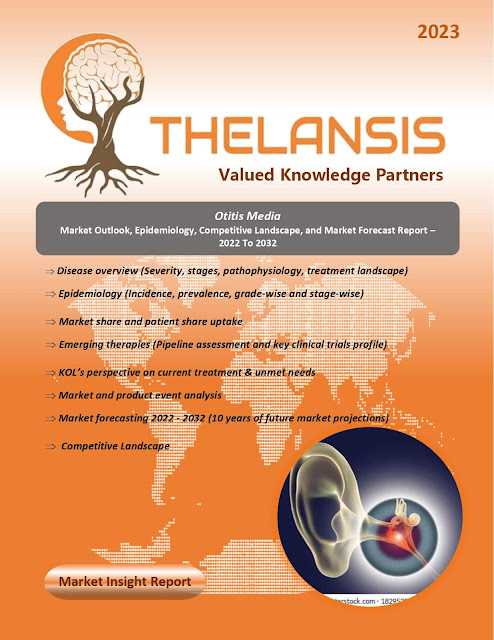Otitis Media – Market Outlook, Epidemiology, Competitive Landscape, and Market Forecast Report – 2022 To 2032
Otitis media is an inflammatory condition affecting the middle ear, potentially arising from bacterial or viral infection. This inflammation, swelling, or infection within the middle ear is known as otitis media (OM). When the eustachian tube experiences poor drainage or becomes blocked, it accumulates fluid in the middle ear space. Subsequently, this fluid can become infected, leading to the development of otitis media. The eustachian tubes can become swollen and congested due to upper respiratory infections, causing an impediment to fluid drainage. This occurrence is widespread in younger children due to the anatomical configuration of their eustachian tubes, which are more horizontally oriented than adults. The causative agents for otitis media encompass the following microorganisms:
·
Streptococcus pneumoniae: 25% to 50%
·
Haemophilus influenzae: 15% to 30%
·
Moraxella catarrhalis: 3% to 20%
Viruses such as respiratory syncytial
virus (RSV), human rhinovirus, adenovirus, coronavirus, enterovirus, and
parainfluenza: 5% to 22% Two distinct types of otitis media are diagnosed:
1. Acute OM:
Often follows an upper respiratory tract infection or allergy. Commonly
implicated microorganisms include Streptococcus pneumoniae (40% to 50%),
Haemophilus influenzae (30% to 40%), and Moraxella catarrhalis (10% to 15%).
2. Chronic OM
(serous, secretory, or nonsuppurative OM; chronic OM with effusion; or glue
ear): Characterized by persistent middle ear swelling. Acute OM affects roughly
two-thirds of American children by age 2, while chronic OM affects a similar
proportion of children under 6. Otitis media is the most prevalent diagnosis in
children and contributes to over 50% of pediatrician visits.
Primary
risk factors linked to otitis media include attending daycare, exposure to
wood-burning stoves, parental smoking or secondhand smoke exposure, food
allergies, lack of breastfeeding, pacifier usage, previous antibiotic use,
winter season, underlying rhinitis, cleft palate, and Down’s syndrome.
·
In the United States, approximately 23% of
children experience an episode of acute otitis media before reaching one year,
rising to around 60% by age three.
Thelansis’s “Otitis Media Market
Outlook, Epidemiology, Competitive Landscape, and Market Forecast Report – 2022
To 2032" covers disease overview, epidemiology, drug utilization,
prescription share analysis, competitive landscape, clinical practice,
regulatory landscape, patient share, market uptake, market forecast, and key
market insights under the potential Otitis Media treatment modalities options
for eight major markets (USA, Germany, France, Italy, Spain, UK, Japan, and
China).
KOLs insights
of Otitis Media across 8 MM market from the centre of Excellence/ Public/
Private hospitals participated in the study. Insights around current treatment
landscape, epidemiology, clinical characteristics, future treatment paradigm,
and Unmet needs.
Otitis Media Market Forecast Patient
Based Forecast Model (MS. Excel Based Automated Dashboard), which Data Inputs
with sourcing, Market Event, and Product Event, Country specific Forecast
Model, Market uptake and patient share uptake, Attribute Analysis, Analog
Analysis, Disease burden, and pricing scenario, Summary, and Insights.
Thelansis Competitive Intelligence (CI) practice
has been established based on a deep understanding of the pharma/biotech
business environment to provide an optimized support system to all levels of
the decision-making process. It enables business leaders in forward-thinking
and proactive decision-making. Thelansis supports scientific and commercial
teams in seamless CI support by creating an AI/ ML-based technology-driven
platform that manages the data flow from primary and secondary sources.




Comments
Post a Comment